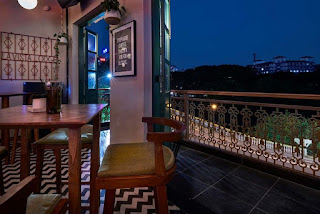 |
| Goa's Fountanhas,India Alamy.com |
 |
| Goa's Fountanhas,India golokaso.com |
Goa is bestowed with many site-seeing sites - old Portuguese churches of heritage value, old Portuguese bungalows, nice beaches etc. Besides, a visit to Fontainhas, the oldest Latin Quarter in Goa, close to the hustle and bustle of Panjim city, will thrill you. Streets flanked by brightly colored traditional house will not only cut down the din from the city, but also will surprise you by their strong Portuguese influence.The cute, vibrant homes lined along the winding streets in this small neighborhood have an old charm that is quite irresistible.
 |
| Fountainhas, latin quarter, Goa, Indiasoultravelling.in |
Fontainhas (or Bairro das Fontainhas, in Portuguese), a well-known old Latin Quarter in Panjim, capital city of the state of Goa, is the legacy of early colonial Portuguese rule India and is one of the three areas earmarked as a conservation zone. The fine architecture, old villas and building with projecting balcony, heritage hotels and boutiques with colonnades painted in the traditional tones pale, green or blue and red colored tiled roof, not to speak of winding streets reflect the impact of Portuguese influence and their culture. The areas that fall within the conservation zone bring out the heritage ambiance and here most of the houses have slanting roof to safeguard against heavy rains during the SW monsoon season. Invariably, the brick houses are made of lime and sand mortar and the walls are lime plastered with eggshells. In this old quarter, there is also a wishing well, an old artifact, in which people could drop a coin or two and make a wish.
Designed by Raya Shankhwalker, a well known architect and secretary of the Goa Heritage Action Group, an NGO dedicated to restoring Goa’s heritage, a new watering hole Soho Goa, it is said,attracts lots of tourists. A lodge was turned into a pub. Known as the La Vista Lodge in the 19th century Goa, not far away from Sultan Adil Shah’s palace, its is a 3 story structure. Soho occupies the upper levels and , the ground floor is for dinning. The entry to the building is set on the side to save the space for bar-seating and dance. With a neon name board atop, this building looks different on the street with a coat of weather-proof paint whose tonal color is not in tune with the traditional old-style color painting The dinning hall retains the ambiance old Goa with marble-topped tables and modern decor. As mentioned earlier on the upper floor,there is an open bar counter and stools and a dance floor. The balcony is newly added matching the one on the lower level. The original wooden floor that could bear heavy load is replaced with concrete floor without compromising on the heritage value and look. This is true of banisters and sign display that reads "La Vista Lodge". Such old Goan buildings are on the decline due to aging and whatever is left needs to be preserved as the typical Goan architecture is culturally sensitive The influx of industries in the quiet part of North Goa and rampant urbanization may impact such structures. of heritage value.
 |
| Bar at Soho, Fontainhas Goaa.rchitecturaldigest.in , |
 |
| cocktail bar. one of Soho Goa’s balconies. architecturaldigest.in |
Fontainhas came up in the late 18th century and the founder was one Antonio Joao de Sequeira (nicknamed Mossmikar), a Goan expatriate who made his fortune in in Mozambique, Africa. The name has its origin from a spring at the foot of the hill which began to sprout around 1770. It is on the line of Lisbon’s Bairo Alto. In 1844, A government administrator in 1844 wanted the people in the lower class to appear properly dressed in public. Antonio built an impressive street with a parapet called the Rua Nova d’Ouremsea on the seaward side of the Fontainhas Bairro (Quarter). In the same area, he also created the Phenis fountain, with a facade and porch. In the colonial time the affluent people lived in bungalows built on the Panjim hill while less affluent people at the foot hill in between tidal creek and hill. The people had to put up with the stench from the dry tidal creek during low-flow seasons.



.jfif)




.jfif)
.jfif)

.jpg)